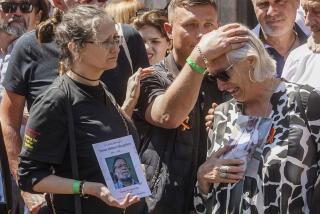Britain eases ban on livestock movement
LONDON — Officials battling an outbreak of foot-and-mouth disease have begun to ease the nationwide ban on animal movement from farms to slaughterhouses, but are continuing to kill animals at risk for the infection in an effort to stop its spread from southeast England.
Movement of animals at risk of the disease is still banned throughout Britain, but livestock owners outside the danger zone in the county of Surrey are being allowed, under license, to transport both live and dead animals, the nation’s chief veterinary officer, Debby Reynolds, said Wednesday.
Reynolds told reporters that a third herd of cattle adjacent to an infection area had been culled Wednesday “on suspicion of foot-and-mouth disease.”
“I cannot rule out disease developing on the premises,” she said of the farm where the herd was killed.
About 200 cattle and other hoofed animals in the villages of Normandy and Elstead in the county of Surrey have been killed since the outbreak was discovered last week.
Reynolds said the virus, identified as 01 BFS 67, has not been seen in the animal world since 1967 and may have come from holdings by the British Institute for Animal Health and the U.S.-owned Merial Animal Health Co., which have operations in nearby Pirbright.
Investigators do not know how the virus would have been unleashed.
“Release by human movement must also be considered a real possibility,” according to a preliminary report by the government’s Health and Safety Executive. “There are various potential routes for accidental or deliberate transfer of material from the site.”
Investigators will examine water and sewage systems shared by the labs. Recent flooding caused the networks to overflow. Tests on the water in those systems should be released today, the BBC reported Wednesday.
A statement by Merial denied that waste water could affect ground outside the institute.
“Merial does not release water from the shared Pirbright site,” the statement said. “We ensure that the water we use in our virus production is treated.”
Merial’s expertise in animal infections is renowned, says Alun Williams, professor of animal pathology and infectious diseases at the Royal Veterinary College in London. “They are caught in the middle -- part of the investigation is about them, but they are actually the world’s experts. . . . The Pirbright site is a world reference laboratory for animal disease, and they help other countries in controlling disease.”
British farmers are faced with the grim prospect of further outbreaks of the highly contagious illness that weakens cloven-footed animals, including cattle, sheep and pigs, and with further precautionary slaughter of their herds.
Culling, rather than vaccination, is still the preferred method of control, officials said.
“No vaccination is 100%,” Williams said. In addition, he said, no test can distinguish between a vaccinated animal and one that has had a previous infection from the virus.
Authorities nonetheless have ordered 300,000 vaccines “to ensure full preparedness,” Reynolds said early this week.
Rural communities are still haunted by a 2001 epidemic, during which 7 million animals were destroyed and huge piles of burning carcasses dotted the countryside. The government at the time was accused of lapses in controlling the disease and of culling unnecessarily. Farmers eventually received about $2.7 billion in compensation. By contrast, the current government has been praised for its quick reaction to the first signs of the disease last week.
“I’m very impressed with the chief veterinary officer, in how she has handled the present outbreak,” said Williams, who worked in the field during the 2001 outbreak. “So far, it’s gone as smoothly as anything like this can go.”
Authorities set up a “protection zone” of about 1.6 square miles, and a wider “surveillance zone” of about 4 square miles shortly after the first cases were discovered.
Farmer Roger Pride, whose entire herd of more than 60 beef cattle was culled over the weekend, told a news conference Tuesday that his family had spent 50 years building up his organic beef cattle business. He said he suspected a leaking drain from the science laboratories about four miles away, which he said had flooded a field where the cattle were grazing.
“Twenty-five percent of the field was flooded, and there was a smell of sewage . . . sewage could have come up through the manhole covers,” he said.
“There is shock in the farming community at the moment that could very easily turn to anger,” said Anthony Gibson of the National Farmers’ Union.
Costs to farming and ancillary industries will run into millions of dollars as trade in British meat and livestock has come to a halt for at least three more months. In a Financial Times report, the British Meat and Livestock Federation estimated that the ban on exports would cause a loss of about $20 million a week.
More to Read
Sign up for Essential California
The most important California stories and recommendations in your inbox every morning.
You may occasionally receive promotional content from the Los Angeles Times.










